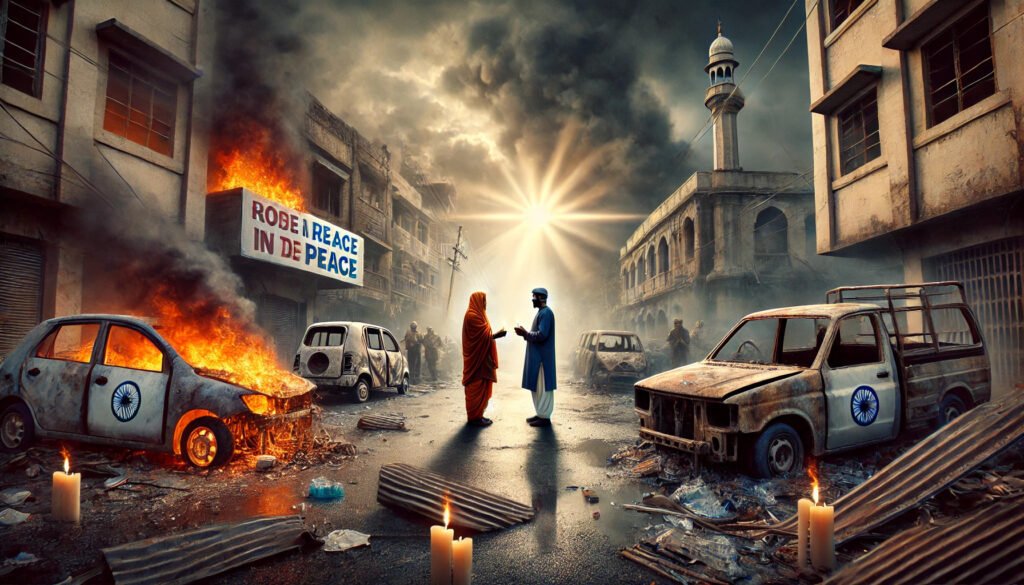indians Together Nurturing Indias's Pluralistic ethos
we are committed to building a cohesive india, where every indian feels secure
INDIANS TOGETHER
India Riots 2024: Rising Communal Tensions and the Path to Harmony

Introduction: India’s Rising Communal Tensions
India experienced a sharp 84% rise in communal riots in 2024, highlighting an alarming trend of division. Reports documented 59 incidents, up from 32 in 2023, with Maharashtra, Uttar Pradesh, and Bihar emerging as hotspots. Many clashes coincided with religious festivals like Ganesh Chaturthi and Bakri Eid, demonstrating how such occasions are misused to ignite unrest.
This article explores historical lessons, political influences, and actionable solutions to promote unity and prevent further violence.
Leadership and Harmony in Yelahanka: A Personal Reflection
In the early 1950s, my father served as a municipal councilor and later as the mayor of Yelahanka. During a Ganesha immersion procession that passed a mosque, he and the then-Mayor Ramaswamy requested the crowd to lower the noise out of respect. This peaceful agreement continued for years and reflected a time when unity and respect prevailed over division.
Today, as political shifts reshape Karnataka, the need for similar leadership is more pressing than ever. My hope is that modern leaders—especially from the BJP—will prioritize harmony and progress rather than exploiting religious differences for political gain.
Religious Festivals: Flashpoints for Violence
Many riots in 2024 were triggered during religious celebrations, exposing how these events are increasingly politicized. Maharashtra witnessed 12 incidents, while Uttar Pradesh and Bihar reported seven each. Clashes erupted during Pran Pratishtha at Ayodhya Ram Mandir, Saraswati Puja immersions, Ganesh festivals, and Bakri Eid.
While festivals should celebrate cultural richness, they are now manipulated to stoke communal divisions, harming India’s social fabric.
Historical Figures and Misinterpretations
Leaders like Tipu Sultan, who fought against British colonialism and introduced economic reforms, are often misrepresented to fuel modern political narratives. Similarly, disputes over Baba Budangiri’s shrine in Karnataka reflect how history is distorted to deepen communal divides. Such reinterpretations, rather than fostering unity, create lasting mistrust and animosity.
Maharashtra and Other Hotbeds of Riots
Maharashtra topped the list of communal clashes in 2024, becoming the epicenter of mob lynchings and religious violence. Uttar Pradesh and Bihar followed closely, highlighting a broader pattern of unrest. Political rhetoric, provocative processions, and distorted historical claims were primary triggers.
The economic cost of these incidents is high—disrupting trade, tourism, and investments. Economic growth and stability can only be restored through peacebuilding efforts and accountability at all levels.
Leadership, Accountability, and the Path Forward
Effective leadership is crucial for fostering unity and trust. Leaders must focus on economic development, education, and social reforms to bridge gaps and heal divisions. Drawing inspiration from pluralistic societies like the U.S., India can build a cohesive future by promoting inclusion and tolerance.
Interfaith dialogues, cultural programs, and educational campaigns can further counter misinformation and restore harmony. Economic stability depends on addressing communal unrest, and a focus on shared prosperity can unite communities.
Conclusion: Toward Peace and Progress
India’s diversity is its strength, but recent trends in communal violence threaten this foundation. Political agendas should not override social harmony, and citizens must advocate for leaders who prioritize unity over division.
By learning from the past and embracing inclusive policies, India can harness its potential and secure a prosperous, peaceful future.
FAQs
1. Why did communal riots increase in India in 2024?
Religious processions, political rhetoric, and disputes over historical narratives were the main triggers for violence.
2. Which states witnessed the most communal clashes in 2024?
Maharashtra, Uttar Pradesh, and Bihar reported the highest number of incidents.
3. How do festivals contribute to communal tensions?
Religious festivals are often politicized, turning celebrations into platforms for division and unrest.
4. What role does leadership play in preventing communal violence?
Inclusive leadership focused on unity and development can counter divisive rhetoric and restore harmony.
5. What are the economic impacts of communal violence?
Riots disrupt trade, tourism, and investments, leading to economic instability and slowed growth.
6. How can India promote unity amidst diversity?
Promoting interfaith dialogue, education, and cultural exchange programs can foster inclusivity and reduce mistrust.
Thank you.
Mike Ghouse
Cell/Text: (214) 325-1916
Dr. Ghouse is an Interfaith Wedding Officiant. A Muslim, Pluralist, activist, speaker, author, and a social scientist. President/ Center for Pluralism, Director/ World Muslim Congress, and partner at InterfaithMarriages.org – Google search for more
